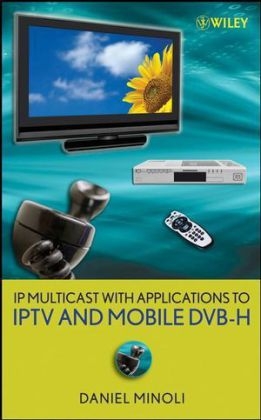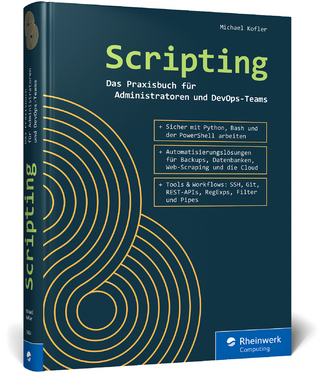
IP Multicast with Applications to IPTV and Mobile DVB-H
Wiley-IEEE Press (Verlag)
978-0-470-25815-6 (ISBN)
Get a clear picture of IP Multicast applications for delivering commercial high-quality video services
This book provides a concise guide to current IP Multicast technology and its applications, with a focus on IP-based Television (IPTV) and Digital Video Broadcast-Handheld (DVB-H) applications—areas of tremendous commercial interest. Traditional phone companies can use IP Multicast technology to deliver video services over their networks; cell phone companies can use it to stream video to handheld phones and PDAs; and many cable TV companies are considering upgrading to IP technology. In addition to applications in industries seeking to provide high-quality digital video and audio, there are numerous other practical uses: multi-site corporate videoconferencing; broad distribution of financial data, stock quotes, and news bulletins; database replication; software distribution; and content caching (for example, Web site caching).
After an introduction that gets readers up to speed on the basics, IP Multicast with Applications to IPTV and Mobile DVB-H:
Discusses multicast addressing for payload and payload forwarding
Covers routing in a variety of protocols, including PIM-SM, CBT, PIM-DM, DVMRP, and MOSPF
Discusses multicasting in IPv6 environments and Multicast Listener Discovery (MLD)
Features examples of IP Multicast applications in the IPTV and mobile DVB-H environments
Includes reference RFCs and protocols placed in the proper context of a commercial-grade infrastructure for the delivery of robust, entertainment-quality linear and nonlinear video programming
This is a concise, compact reference for practitioners who seek a quick, practical review of the topic with an emphasis on the major and most often used aspects of the technology. It serves as a hands-on resource for engineers in the communications industry or Internet design, content providers, and researchers. It's also an excellent text for college courses on IP Multicast and/or IPTV.
Daniel Minoli has many years' experience providing telecommunications, networking, and IT architecture guidance and solutions for such organizations as the Advanced Research Projects Agency (ARPA), Bell Telephone Laboratories, ITT, Prudential Securities, Bell Communications Research (Bellcore/Telcordia), AT&T, Capital One Financial, SES Americom, New York University, Rutgers University, Stevens Institute of Technology, and Société Générale de Financement de Québec. An author of numerous core references on information technology, telecommunications, and data communications, he has also written columns for Computerworld, Network World, and Network Computing.
Preface xiii
About the Author xv
1 Introduction to Ip Multicast 1
1.1 Introduction 1
1.2 Why Multicast Protocols are Wanted/Needed 3
1.3 Basic Multicast Protocols and Concepts 5
1.4 IPTV and DVB-H Applications 11
1.5 Course of Investigation 21
Appendix 1.A: Multicast IETF Request for Comments 21
Appendix 1.B: Multicast Bibliography 23
References 23
2 Multicast Addressing for Payload 26
2.1 IP Multicast Addresses 26
2.1.1 Limited Scope Addresses 29
2.1.2 GLOP Addressing 30
2.1.3 Generic IPv4 Addressing 30
2.2 Layer 2 Multicast Addresses 31
2.2.1 Ethernet MAC Address Mapping 31
2.3 MPEG-Layer Addresses 33
References 38
3 Multicast Payload Forwarding 39
3.1 Multicasting on a LAN Segment 40
3.2 Multicasting between Network Segments 40
3.3 Multicast Distribution Trees 41
3.4 Multicast Forwarding: Reverse Path Forwarding 47
3.5 Multicast Forwarding: Center-Based Tree Algorithm 48
3.6 Implementing IP Multicast in a Network 49
References 50
4 Dynamic Host Registration—internet Group Management Protocol 51
4.1 IGMP Messages 52
4.2 IGMPv3 Messages 55
4.3 IGMP Operation 61
Appendix 4.A: Protocol Details for IGMPv 2 63
4.A.1 Overview 63
4.A.2 Protocol Description 64
4.A.3 Receiver (Host) State Diagram 65
4.A.4 Router State Diagram 69
Appendix 4.B: IGMP Snooping Switches 72
Appendix 4.C: Example of Router Configurations 76
References 77
5 Multicast Routing—sparse-mode Protocols: Protocol Independent Multicast 78
5.1 Introduction to PIM 79
5.2 PIM SM Details 83
5.2.1 Approach 86
5.2.2 PIM SM Protocol Overview 86
5.2.3 Detailed Protocol Description 94
5.2.4 Packet Formats 114
References 124
6 Multicast Routing—sparse-mode Protocols: Core-based Trees 125
6.1 Motivation 126
6.2 Basic Operation 127
6.3 CBT Components and Functions 129
6.3.1 CBT Control Message Retransmission Strategy 131
6.3.2 Nonmember Sending 131
6.4 Core Router Discovery 131
6.5 Protocol Specification Details 132
6.5.1 CBT HELLO Protocol 133
6.5.2 JOIN_REQUEST Processing 134
6.5.3 JOIN_ACK Processing 135
6.5.4 QUIT_NOTIFICATION Processing 135
6.5.5 ECHO_REQUEST Processing 136
6.5.6 ECHO_REPLY Processing 137
6.5.7 FLUSH_TREE Processing 137
6.5.8 Nonmember Sending 138
6.5.9 Timers and Default Values 138
6.5.10 CBT Packet Formats and Message Types 138
6.5.11 Core Router Discovery 142
6.6 CBT Version 3 145
6.6.1 The First Step: Joining the Tree 145
6.6.2 Transient State 146
6.6.3 Getting ‘‘On Tree’’ 146
6.6.4 Pruning and Prune State 147
6.6.5 The Forwarding Cache 147
6.6.6 Packet Forwarding 148
6.6.7 The ‘‘Keepalive’’ Protocol 148
6.6.8 Control Message Precedence and Forwarding Criteria 149
6.6.9 Broadcast LANs 149
6.6.10 The ‘‘all-cbt-routers’’ Group 150
6.6.11 Nonmember Sending 150
References 151
7 Multicast Routing—dense-mode Protocols: Pim Dm 152
7.1 Overview 152
7.2 Basic PIM DM Behavior 153
7.3 Protocol Specification 155
7.3.1 PIM Protocol State 156
7.3.2 Data Packet Forwarding Rules 158
7.3.3 Hello Messages 159
7.3.4 PIM DM Prune, Join, and Graft Messages 160
7.3.5 State Refresh 170
7.3.6 PIM Assert Messages 175
7.3.7 PIM Packet Formats 182
References 184
8 other Dense-mode Multicast Routing Protocols: Dvmrp and Mospf 185
8.1 Distance Vector Multicast Algorithm 185
8.1.1 Overview 185
8.1.2 Basic DVMRP Operation 186
8.2 Multicast OSPF 190
References 193
9 IP MULTICASTING IN IPv6 ENVIRONMENTS 194
9.1 Opportunities Offered by IPv 6 194
9.2 Introductory Overview of IPv 6 196
9.2.1 IPv6 Benefits 197
9.2.2 Traditional Addressing Classes for IPv 4 198
9.2.3 Network Address Translation Issues in IPv 4 199
9.2.4 IPv6 Address Space 200
9.2.5 Basic Protocol Constructs 201
9.2.6 IPv6 Autoconfiguration 204
9.3 Migration and Coexistence 208
9.4 Multicast with IPv 6 211
9.4.1 IPv6 Multicast Addresses 211
9.4.2 MAC Layer Addresses 211
9.4.3 Signaling 213
9.4.4 RP Approaches 213
References 213
10 Multicast Listener Discovery 215
10.1 Overview of MLDv 1 216
10.2 Message Format 216
10.3 Protocol Description 218
10.4 Node State Transition Diagram 220
10.5 Router State Transition Diagram 223
10.6 Overview of MLDv 2 226
10.6.1 Protocol Overview 227
10.6.2 Building Multicast Listening State on Multicast Address Listeners 228
10.6.3 Exchanging Messages between the Querier and the Listening Nodes 228
10.6.4 Building Multicast Address Listener State on Multicast Routers 230
10.7 Source Filtering 232
References 233
11 Iptv Applications 234
11.1 Overview and Motivation 234
11.2 Basic Architecture 236
11.2.1 Content Aggregation Subsystem 244
11.2.2 Uniform Transcoding Subsystem 245
11.2.3 Conditional-Access Management Subsystem 251
11.2.4 Encapsulation Subsystem 258
11.2.5 Long-Haul Distribution Subsystem 262
11.2.6 Local Distribution Subsystem 264
11.2.7 Middleware Subsystem 267
11.2.8 Set-Top Boxes 267
11.2.9 Catcher (for VoD Services) 269
Appendix 11.A: Serial Digital Interface Basics 269
Appendix 11.B: MPEG Basics 271
11.B.1 MPEG-2 Transport/Multiplexing Mechanisms 271
11.B.2 IPTV/IP Transmission over TS Logical Channels 279
11.B.3 Compression Technology 281
Appendix 11.C: Encapsulation for Transmission of IP Datagrams over MPEG-2/DVB Networks 298
References 300
12 Dvb-h: High-quality TV to Cell Phones 303
12.1 Background and Motivation 304
12.2 Basic DVB-H Technology 311
12.2.1 DVB-H Mobile Devices 315
Appendix 12.A: Open Mobile Video Coalition Efforts 317
References 318
Glossary 319
Index 349
| Erscheint lt. Verlag | 21.4.2008 |
|---|---|
| Reihe/Serie | IEEE Press |
| Sprache | englisch |
| Maße | 164 x 240 mm |
| Gewicht | 660 g |
| Einbandart | gebunden |
| Themenwelt | Mathematik / Informatik ► Informatik ► Netzwerke |
| Technik ► Elektrotechnik / Energietechnik | |
| Technik ► Nachrichtentechnik | |
| ISBN-10 | 0-470-25815-2 / 0470258152 |
| ISBN-13 | 978-0-470-25815-6 / 9780470258156 |
| Zustand | Neuware |
| Haben Sie eine Frage zum Produkt? |
aus dem Bereich


